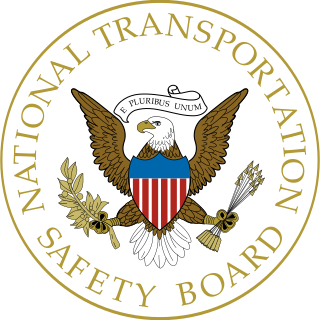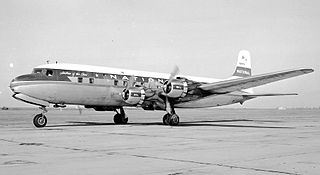
Hani Saleh Hasan Hanjour was one hijacker-pilot of American Airlines Flight 77, crashing the plane into the Pentagon as part of the September 11 attacks.

The National Transportation Safety Board (NTSB) is an independent U.S. government investigative agency responsible for civil transportation accident investigation. In this role, the NTSB investigates and reports on aviation accidents and incidents, certain types of highway crashes, ship and marine accidents, pipeline incidents, and railroad accidents. When requested, the NTSB will assist the military and foreign governments with accident investigation. The NTSB is also in charge of investigating cases of hazardous materials releases that occur during transportation. The agency is based in Washington, D.C. It has four regional offices, located in Anchorage, Alaska; Denver, Colorado; Ashburn, Virginia; and Seattle, Washington. The agency also operates a national training center at its Ashburn facility.

Embry–Riddle Aeronautical University (ERAU) is a private university focused on aviation and aerospace programs with its main campuses in Daytona Beach, Florida, and Prescott, Arizona, United States. It is the largest accredited university system specializing in aviation and aerospace. It has numerous online programs and academic programs offered at satellite locations.
The Air Commerce Act of 1926 created an Aeronautic Branch of the United States Department of Commerce. Its functions included testing and licensing of pilots, certification of aircraft and investigation of accidents.

The Civil Aeronautics Board (CAB) was an agency of the federal government of the United States, formed in 1938 and abolished in 1985, that regulated aviation services including scheduled passenger airline service and provided air accident investigation. The agency headquarters were in Washington, D.C.

Capital Airlines was an airline serving the eastern, southern, southeastern, and midwestern United States. Capital's headquarters were located at Washington National Airport across the Potomac river from Washington, D.C. where crew training and aircraft overhauls were also accomplished. In the 1950s Capital was the fifth largest United States domestic carrier by passenger count after the Big Four air carriers.

National Airlines Flight 2511 was a United States domestic passenger flight from New York City to Miami, Florida. On January 6, 1960, the Douglas DC-6 serving the flight exploded in midair. The National Airlines aircraft was carrying 5 crew members and 29 passengers, all of whom perished. The Civil Aeronautics Board investigation concluded that the plane was brought down by a bomb made of dynamite. No criminal charges were ever filed, nor was the blame for the bombing ever determined, though a suicide bombing is suspected. The investigation remains open today.

The Martin 4-0-4 was an American pressurized passenger airliner built by the Glenn L. Martin Company. In addition to airline use initially in the United States, it was used by the United States Coast Guard and United States Navy as the RM-1G.
The Division of Military Aeronautics was the name of the aviation organization of the United States Army for a four-day period during World War I. It was created by a reorganization by the War Department of the Aviation Section, U.S. Signal Corps on April 24, 1918, still as part of the Signal Corps. It was removed from the Aviation Section by executive order on May 20, 1918, and existed as the sole Army aviation agency until a War Department general order issued May 24, 1918, established it and the Bureau of Aircraft Production, created by the same reorganization on April 24, as coordinate components of the "Air Service". As such, it is recognized by the United States Air Force as the third of its antecedents.
Zantop Air Transport was a United States airline formed from Zantop Flying Service in 1962. The Civil Aeronautics Board approved transfer of the operating certificate of Coastal Airlines to Zantop Air Transport, which had incorporated and become a supplemental air carrier. The former company had been a hauler for the Big Three automakers. With the new arrangement Zantop could provide individually waybilled services. The original founders of Zantop Flying Services, the Zantop brothers, all sold their stock and resigned from the company in 1966, at which time it became Universal Airlines, Inc.

The Civil Aviation Authority of the Philippines is the national aviation authority of the Philippines and is responsible for implementing policies on civil aviation to assure safe, economic and efficient air travel. The agency also investigates aviation accidents via its Aircraft Accident Investigation and Inquiry Board. Formerly the Air Transportation Office, it is an independent regulatory body attached to the Department of Transportation for the purpose of policy coordination.

TWA Flight 3 was a twin-engined Douglas DC-3-382 propliner, registration NC1946, operated by Transcontinental and Western Air as a scheduled domestic passenger flight from New York City, to Burbank, California, via Indianapolis, Indiana, St. Louis, Missouri, Albuquerque, New Mexico, and Las Vegas, Nevada. On January 16, 1942, at 19:20 PST, 15 minutes after takeoff from Las Vegas Airport bound for Burbank, the aircraft crashed into a sheer cliff on Potosi Mountain, 32 miles (51 km) southwest of the airport, at an elevation of 7,770 ft (2,370 m) above sea level, and was destroyed. All 22 people on board — including movie star Carole Lombard, her mother, and three crew members — died in the crash. The Civil Aeronautics Board (CAB) investigated the accident and determined it was caused by a navigation error by the captain.
AAXICO was an airline based in the United States.

The Federal Aviation Act of 1958 was an act of the United States Congress, signed by President Dwight D. Eisenhower, that created the Federal Aviation Agency and abolished its predecessor, the Civil Aeronautics Administration (CAA). The act empowered the FAA to oversee and regulate safety in the airline industry and the use of American airspace by both military aircraft and civilian aircraft.

Arizona is a state in the southwestern region of the United States. It is also part of the Western and the Mountain states. It is the 6th largest and the 14th most populous of the 50 states. Its capital and largest city is Phoenix. Arizona shares the Four Corners region with Utah, Colorado, and New Mexico; its other neighboring states are Nevada and California to the west and the Mexican states of Sonora and Baja California to the south and southwest.

Inflight smoking is prohibited by almost all airlines. The bans on inflight smoking have been imposed in a piece-meal manner around the world beginning in the 1980s.

American Airlines Flight 28 was a scheduled domestic passenger flight that crashed on October 23, 1942, in Chino Canyon, near Palm Springs, California, after being struck by a United States Army Air Forces B-34 'Lexington' bomber. The B-34 suffered only minor damage, and landed safely at the Army Airport of the Sixth Ferrying Command, Palm Springs, California.

On 7 June 1949, a Strato-Freight Curtiss Wright C-46D, registered in the United States as NC92857, crashed into the Atlantic Ocean 10 km (6.4 mi) west of San Juan-Isla Grande Airport in San Juan, Puerto Rico while en route to Miami, Florida. Of the 81 passengers and crew on board, 53 were killed.

On 12 July 1953, Transocean Air Lines Flight 512, a Douglas DC-6A operated by Transocean Air Lines from Guam to Oakland, California, crashed into the Pacific Ocean roughly 630 km (340 nmi) east of Wake Island while en route to Honolulu for a planned stopover. All 58 passengers and crew on board were killed.















